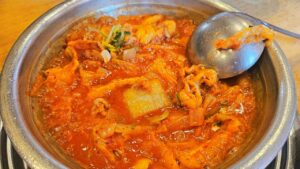Before coming to Korea, I had never been immersed in an environment where I wasn’t able to communicate or understand the space I was in. I wondered to myself: How was I going to navigate this country as someone who does not speak or understand the language?
If you don’t have experience with Korean, just like with any new language, speaking might feel daunting and even uncomfortable at first. However, it’s essential to approach the situation with respect for the culture and country you’re in, especially as a foreigner.
By starting with the little things, such as learning basic greetings or common phrases, you can demonstrate your respect for the Korean customs and culture. Trust me when I say that with enough practice and effort, in time you will grow more confident in your communication skills!
From native Korean cuisine, street food delicacies, open air markets, convenience store treats and all kinds of aesthetic cafes, it’s safe to say trying and purchasing new food will happen often! This means it’s a great opportunity to practice your Korean. Today, I’m here to tell you the basic phrases I used to purchase food during my first week in Korea!


1. annyeonghaseyo/안녕하세요/hello and kamsahamnida/감사합니다/thank you
While not directly related to the ordering of food itself, understanding how to greet people and thank them for their services is essential for showing respect to others, regardless of where you are in the world. In Korea, whenever I enter an establishment, I greet people with “Annyeonghaseyo.” After our transaction is complete, my order is taken, or I am leaving the establishment, I say “Kamsahamnida.”
Tip: Make sure to say both phrases while bowing your head. In Korean culture, bowing signifies respect and politeness.
2. igeo juseyo/이거 주세요/this please and juseyo/주세요/please
As someone with a very limited understanding of the Korean language, these two phrases were especially helpful for me during my first week in Seoul. If the menu is all in Korean, I would first use PapaGo, an essential and translation app here in Korea, to snap a photo of it and understand it! Once I knew what I wanted, I could point to the item and say “igeo juseyo” meaning “this please.”
Something else I did was translate the name of the item I wanted in Korean, and add “juseyo”, Korean for please, at the end of that word. For example, the Korean word for water is “mul.” To ask for water, I could say: “Mul juseyo.”
3. igeo eol maayeyo/이거 얼마예요/how much is this
This phrase was especially helpful for purchasing street food if prices were not labeled. Some vendors might say the cost of your desired item in English, while others might type it out in a calculator for you to see. Similar to the previous two phrases, you can point to what you want to purchase and ask “igeo eol maayeyo”?
If you are planning on working or studying in Korea, I highly recommend that you take the time to truly learn the language, and learn phrases beyond the introductory ones I’ve mentioned above. It’s important to put effort into appreciating the culture you are in. There are plenty of resources on YouTube and online that can help you if it’s your first time learning the language like me. It will be difficult, but remember to be patient with yourself and try your best! We’re all learning.










